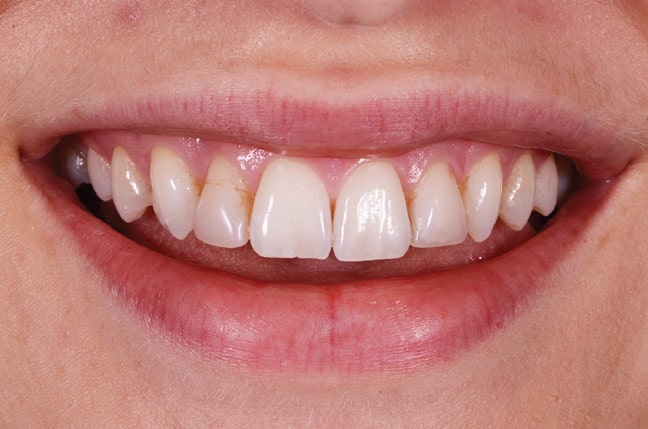Evolution of Treating Maxillary Lateral Incisors
This case report details the use of porcelain veneers on a young patient originally restored esthetically with composite.
The use of composite resin on small maxillary lateral incisors can be a good choice for a young patient and buy time until the patient’s growth is complete and porcelain becomes a viable restorative option.
The combination of composite resin and porcelain is an ideal treatment to meet the esthetic and functional demands of restoring small lateral incisors. Composite resin is an excellent choice to use early in the patient’s life to establish form, function and esthetics (Figure 1). It can be added to and repaired easily as tooth color and tissue levels change. Upon completion of growth and the eruption of permanent teeth, porcelain gives another potentially more esthetic and definitive option to restore an undersized maxillary lateral incisor.

CASE REPORT
The following case highlights these points, as my office treated this patient from an early age, throughout adolescence, and as a young adult when she wanted a more esthetic restoration. Her options for a more esthetic appearance included composite or porcelain. She ultimately chose porcelain veneers for teeth #7 and 10.
The patient had congenitally small lateral incisors, and, when she was a young teenager, she wanted to improve the look of the peg laterals. Composite resin was added to the teeth as conservatively as possible, with little enamel being removed. These restorations remained until the patient moved to New York City, where she pursued acting and felt a more attractive smile could enhance her career. The initial treatment involved completing a diagnostic wax-up from which provisionals could be fabricated that closely mimicked the final desired outcome.

At the prep appointment, all of the existing composite was removed, provisionals were created by using a putty matrix made from the wax-up, and conservative tooth prep was performed into the bisacryl to avoid unnecessary removal of enamel (Figure 2). This also helped ensure uniform thickness of the porcelain veneers. Finally, an impression was taken and provisionals were fabricated. Delivery of the veneers followed in several weeks when she could return to our North Carolina office (Figure 3 and Figure 4).

CONCLUSION
This case presented the challenge of creating restorations with the correct hue, chroma and value, as well as an ideal surface texture, polish and shape that would support optimal gingival health. Matching the imperfections and subtle nuances of the adjacent teeth aids in creating a restoration that seamlessly integrates with the patient’s smile.

When the quality of preparation, temporization, gingival management and communication is matched by the lab technician’s ceramic artistry, the results can be extremely gratifying for the dental team and ceramist — and, most importantly, life changing for the patient.
Acknowledgment: The author is grateful for the ceramic artistry of Hiroshi Kobayashi and for the memory of his father and first practice partner, Joel Hedgecoe, DDS.
Adapted with permission, Journal of Cosmetic Dentistry. ©2022. American Academy of Cosmetic Dentistry. All rights reserved. 608-222-8583; AACD.com.
American Academy of Cosmetic Dentistry
800-543-9220
From Decisions in Dentistry. October 2022;8(10)26.


